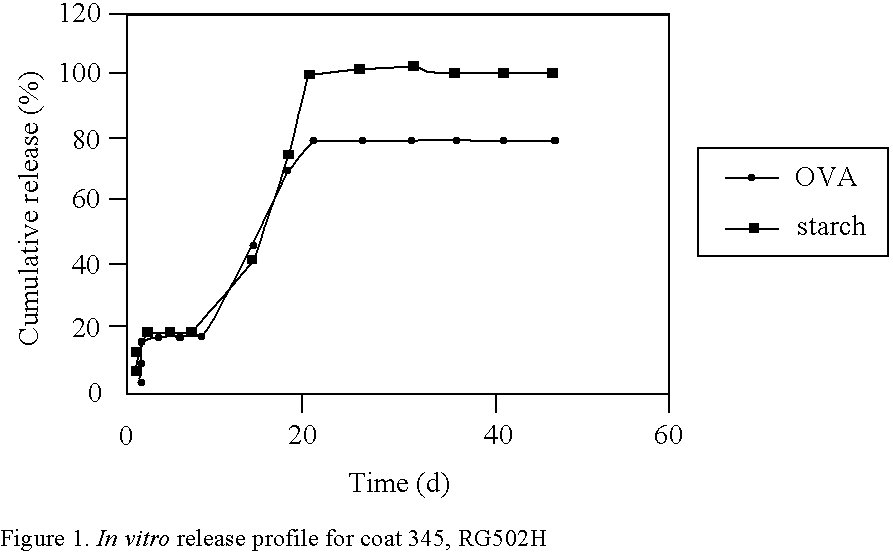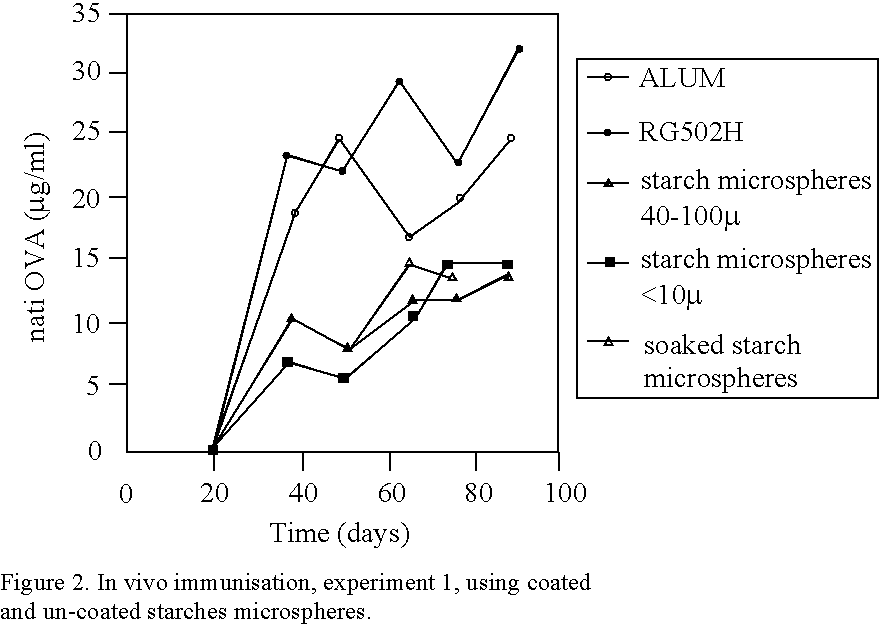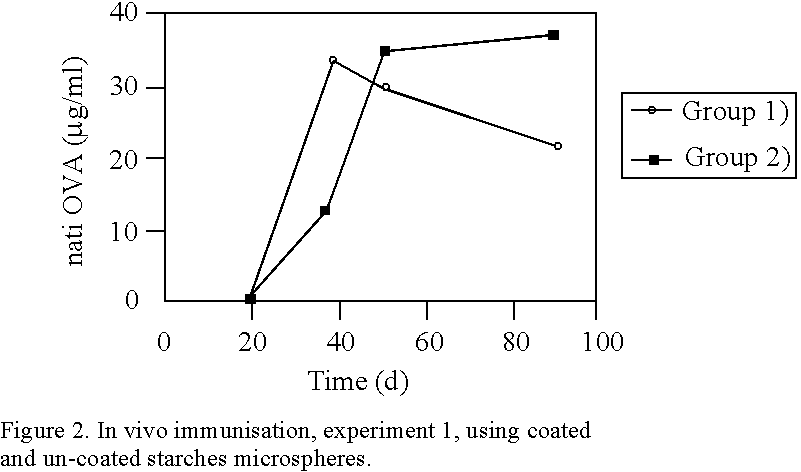Many vaccines have to be administered by injection, often repeatedly, since they are either subjected to degradation or are insufficiently absorbed when they are given, for example, orally or nasally or by the rectal
route and therefore do not give the desired immune response unless injected into the body.
In other words, they consist of amino acids condensed into a
polymer having a relatively low
degree of polymerization and they do not have any well-defined three-dimensional structure.
For example,
extrusion and subsequent size-reduction can be utilized, which techniques would probably not be allowed in connection with proteins, since these do not, generally speaking, withstand such stringent conditions.
A very serious drawback connected with the use of
PLGA, which is an excellent material per se, for delayed release of proteins is therefore the need to use organic solvents to dissolve the said
PLGA, with the attendant risk that the stability of the
protein will be compromised and that conformation changes in the
protein will lead to an immunological reaction in the patient, which can produce both a loss of
therapeutic effect, through the formation of
inhibitory antibodies, and toxic side effects.
Despite intense efforts aimed at modifying the
PLGA technology in order to avoid this inherent problem of
protein instability during the production process, progress within this field has been very slow, the main reason probably being that the three-dimensional structures for the majority of proteins are far too sensitive to withstand the manufacturing conditions used and the chemically acidic environment formed with the degradation of PLGA matrices.
Should the microspheres have a greater
diameter, the pH value can be expected to fall further owing to the fact that the acidic degradation products then get more difficult to diffuse away and the
autocatalytic reaction is intensified.
However, this still remains to be clearly demonstrated for other proteins and the problem remains of exposing the enclosed biologically active substance to a very low pH during the degradation of the PLGA matrix.
In the aforementioned methods based on encapsulation with PLGA, the active substances are still exposed to an
organic solvent and this, generally speaking, is harmful to the stability of a protein.
Moreover, the discussed
emulsion processes are complicated and probably problematical in any attempt to scale up to an
industrial scale.
Furthermore, many of the organic solvents which are utilized in many of these processes are associated with environmental problems and their high affinity for the PLGA
polymer makes their removal difficult.
The obtained microspheres are not suitable for parenteral administrations, especially repeated parenteral administration, for a number of reasons.
Moreover, these microspheres are far too small, <2 .mu.m in
diameter, to be suitable for injection in the tissues for sustained release, since tissue macrophages can easily phagocytize them.
The use of
dextran is also associated with a certain risk of serious allergic reactions.
This leads, in turn, to microspheres having inherent
instability, since the
starch, after resuspension in water and upon
exposure to body fluids, will endeavour to form such cross-links, In order for a water-in-
oil emulsion to be obtained, high shear forces are required and the microspheres which are formed are far too small to be suitable for parenteral sustained release.
The described methodology, in combination with the starch quality which is defined, does not give rise to fully biodegradable particles.
Neither are the obtained particles suitable for injection, particularly for repeated injections over a longer period, since the described starch quality contains far too high quantities of foreign vegetable protein.
The lowest share of
macromolecule, i.e. the biologically active substance, in the preparation is 40%, which for most applications is too high and leads to great uncertainty in the injected quantity of active substance, since the
dose of microparticles becomes far too low.
Even though the manufacturing method is described as mild and capable of retaining the
biological activity of the entrapped biologically active substance, the microparticles are stabilized by heating and, in the examples given, heating is effected to at least 58.degree. C. for 30 min. and, in many cases, to 70-90.degree. C. for an equivalent period, which cannot be expected to be tolerated by sensitive proteins, the
biological activity of which is dependent on a three-dimensional structure, and even where the protein has apparently withstood the manufacturing process, there is still a risk of small, but nonetheless not insignificant changes in the conformation of the protein.
As the outer phase, a combination of two polymers is always used, generally
polyvinyl pyrrolidone and PEG, which complicates the manufacturing process in that both these substances must be washed away from the microspheres in a reproducible and reliable manner.
It is entirely undesirable to chemically cross-link the biologically active
macromolecule, either with itself or with the
microparticle matrix, since chemical modifications of this kind have a number of serious drawbacks, such as reduction of the bioactivity of a sensitive protein and risk of induction of an immune response to the new antigenic determinants of the protein, giving rise to the need for extensive toxicological studies to investigate the safety of the product.
Microparticles which are made through chemical cross-linking with
glutaraldehyde are previously known and are considered generally unsuitable for repeated administrations parenterally to humans.
The microparticles which are described in U.S. Pat. No. 5,578,709 suffer in general terms from the same drawbacks as are described for U.S. Pat. No. 5,981,719, with unsuitable manufacturing conditions for sensitive proteins, either through their
exposure to
chemical modification or to harmful temperatures, and a
microparticle size distribution which is too narrow for parenteral, sustained release and which complicates post-manufacture
processing of the microspheres.
This procedure leads to far too low a content of the biologically active substance, generally 1-2%, and to a very large fraction being released immediately after injection, which very often is entirely unsuitable.
This far too rapid initial release is already very high given a 1% load and becomes even more pronounced when the active
substance content in the microspheres is higher, Upon the degradation of the PLGA matrix, the pH falls to levels which are generally not acceptable for sensitive macromolecules.
Starch granules naturally contain impurities, such as starch proteins, which makes them unsuitable for injection parenterally.
In the event of unintentional depositing of insufficiently purified starch, such as can occur in operations where many types of operating gloves are powdered with stabilized starch granules, very serious secondary effects can arise.
Neither are starch granules intrinsically suitable for repeated parenteral administrations, for the reason that they are not fully biodegradable within acceptable time spans.
Neither the manufacturing method nor the obtained microspheres are suitable for the immobilization of sensitive proteins, and as is evident from the control experiments, nor is acid-hydrolyzed starch suitable for producing either fully biodegradable
starch microspheres or
starch microspheres containing a
high load of a biologically active substance, such as a protein.
HES is not suitable for the production of fully biodegradable microspheres containing a biologically active substance, since the
chemical modification leads to a considerable fall in the speed and completeness of the
biodegradation and results in the
elimination of the natural tendency of the starch to solidify through the formation of non-covalent cross-linkings.
Moreover, highly concentrated solutions of HES become far too viscous to be
usable for the production of microparticles.
The use of HES in these
high doses shows that parenterally
usable starch can be manufactured, even though HES is not
usable for the manufacture of microspheres without chemical cross-linking or
precipitation with organic solvents.
The obtained granules are not suitable for parenteral administration, since they still contain the starch proteins which are present within the granules and there is a risk that residues of the added
proteolytic enzymes will be left in the granules.
Neither are the granules suitable for the manufacture of parenterally administrable
starch microspheres in two-phase aqueous systems, since they have the wrong molecular
weight distribution to be able to be used in high enough concentration, even after being dissolved, and, where microspheres can be obtained, they are probably not fully biodegradable.
The starch which is obtained is not suitable for parenteral administration owing to the high content of starch proteins, which might be present in denatured form after the shearing, and neither is the obtained starch suitable for producing biodegradable starch microspheres for parenteral administration or for use in two-phase aqueous systems for the production of such starch microspheres.
However, for similar reasons such hydroxyethylstarch is not either suitable for parenteral administration or for the production of microspheres as referred to above.
A serious drawback with the preparation process is the exposure of the core containing the
antigen to organic solvents.
Although it has been demonstrated that the core is able to protect
HbsAg from organic solvents like
ethyl acetate and
acetonitrile, this has not been demonstrated for other antigens and it is very undesirable to
expose the
antigen to an
organic solvent at all since this may be harmful to the antigen and may result in
residual solvent in the formulation which may adversely affect the stability of the formulation in general, and the antigen in particular.
It is also not desirable to control the release
kinetics by the thickness of the
coating as this limits the release profiles that are achievable and limits the ratio between the core and the
coating that can be used.
 Login to View More
Login to View More 


